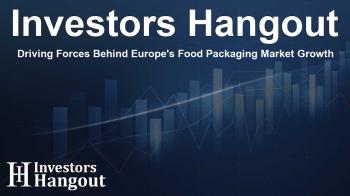Driving Forces Behind Europe's Food Packaging Market Growth

Market Overview of Food Packaging in Europe
The Europe food packaging market is experiencing remarkable growth, having stood at USD 83.64 billion and anticipated to reach USD 124.83 billion in the coming years. This surge is driven primarily by an increasing consumer appetite for convenient and fresh ready-to-eat food products. With growing concerns surrounding sustainability and environmental issues, manufacturers are being influenced to adopt eco-friendly practices in their packaging solutions.
Key Insights Driving Market Dynamics
Several crucial insights emerge from the analysis of the Europe food packaging sector. The plastic material segment maintains the largest market share, dominating in various food categories due to its affordability and adaptability. Notably, paper and paperboard packaging are forecasted to expand rapidly as technology advances and consumer preferences shift towards sustainable options. The major food sectors contributing to market growth include frozen and processed foods, meat and poultry, and ready-to-eat meals.
Rise of Sustainable Innovations
Environmental awareness is reshaping the food packaging landscape in Europe. Stricter regulations have prompted many companies to enhance their sustainability efforts. Businesses are investing significantly in recyclable and biodegradable materials as they strive to minimize their environmental impact.
Exciting Developments in Sustainable Packaging
Innovative companies are pioneering sustainable alternatives. For instance, recent introductions of food products utilizing eco-friendly packaging materials bolster this trend. These efforts show a considerable shift towards sourcing materials that align with a circular economy approach, minimizing waste and embracing recyclability.
Prominent Sustainability Trends in Food Packaging
Recent sustainability trends include a market-wide transition towards a circular economy, where resources are utilized for as long as possible. Mandatory regulations require the inclusion of recycled content and recyclable packaging by 2030. Additionally, bio-based materials are gaining traction, driven by both consumer demand and legislation aimed at reducing reliance on fossil fuels.
Market Growth Overview
The expanding food packaging industry in Europe is attributed to increasing consumer awareness surrounding food safety and quality. Advances in packaging technology, coupled with an increase in urban living and busy lifestyles, are influencing purchasing behaviors favoring convenience foods.
Sustainability as a Core Focus
Leading players in the food packaging market are prioritizing sustainability initiatives. There is a clear industry-wide focus on developing biodegradable and compostable alternatives, which have become essential in enhancing brand reputation and meeting consumer demands for eco-friendly products. Circular packaging models and eco-friendly production methods are gaining ground, guided by evolving EU regulations on carbon footprints.
Market Segment Insights
Material Type: Plastic remains the backbone of the food packaging industry due to its versatility. However, the demand for paper and paperboard options is surging as eco-conscious brands seek sustainable alternatives. These biodegradable materials are especially appealing to environmentally-focused consumers.
Food Type Segmentation: Different food segments show distinctive preferences, with frozen and processed foods leading the market. Meanwhile, meat and poultry sectors are rapidly evolving due to heightened consumer expectations for hygiene and safety.
Forecast and Conclusion
The future of the food packaging market in Europe looks promising. Continuous innovations in technology and materials, combined with proactive regulatory support, will further fuel growth. By focusing on sustainable practices, companies in this sector can enhance their market positions while addressing pressing environmental challenges.
Frequently Asked Questions
1. What is driving growth in the food packaging market in Europe?
Consumer demand for convenient, fresh, and ready-to-eat food products drives growth, supported by sustainability trends.
2. How are companies addressing sustainability in food packaging?
Many companies are shifting to recyclable, biodegradable materials to comply with regulations and meet consumer expectations for eco-friendliness.
3. Which materials dominate the food packaging market?
Plastic remains the dominant material, but there is a rapid increase in demand for paper and paperboard options.
4. What are the key food segments impacting the packaging industry?
Frozen and processed foods, along with meat and poultry, significantly influence packaging trends and innovations.
5. What is the future outlook for the European food packaging market?
The market is expected to grow steadily, driven by technological advancements and a focus on sustainable practices.
About The Author
Contact Evelyn Baker privately here. Or send an email with ATTN: Evelyn Baker as the subject to contact@investorshangout.com.
About Investors Hangout
Investors Hangout is a leading online stock forum for financial discussion and learning, offering a wide range of free tools and resources. It draws in traders of all levels, who exchange market knowledge, investigate trading tactics, and keep an eye on industry developments in real time. Featuring financial articles, stock message boards, quotes, charts, company profiles, and live news updates. Through cooperative learning and a wealth of informational resources, it helps users from novices creating their first portfolios to experts honing their techniques. Join Investors Hangout today: https://investorshangout.com/
The content of this article is based on factual, publicly available information and does not represent legal, financial, or investment advice. Investors Hangout does not offer financial advice, and the author is not a licensed financial advisor. Consult a qualified advisor before making any financial or investment decisions based on this article. This article should not be considered advice to purchase, sell, or hold any securities or other investments. If any of the material provided here is inaccurate, please contact us for corrections.

